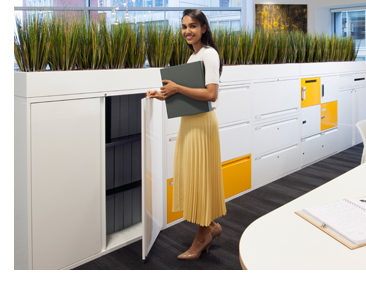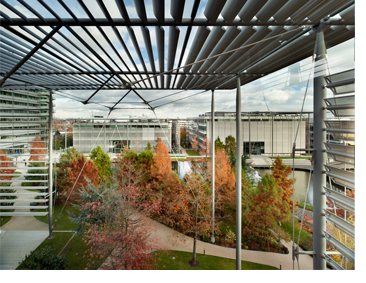Call of the Wild - Bring biophilic design into the workplace
 Joseph Clancy on how biophilic design can create better working and learning environments
Joseph Clancy on how biophilic design can create better working and learning environments
It could be argued that perhaps without deliberate intent, domestic interiors have a well-established history of biophilic design - simply because they reflect our natural preferences, as animals, to be connected to the biosphere that sustains us. Still, in its relative infancy, biophilic design is gaining momentum in the workplace and educational environments, following on from successful implementation in the healthcare, retail and hospitality, and public spaces.
Influential and respected biophilic design consultant Joseph Clancy visited KI’s London offices in April 2017 to share some details about what biophilic design is all about, and the challenges and opportunities organisations should be aware of when creating or refurbishing their physical environments.
[KI] So, what is biophilia & biophilic design?
[JC] Biophilia is a love of life, an innate affinity to associate with nature. It is a hypothesis which states that humans have a deep-seated association with natural environments. Essentially, our brains are hard-wired for nature.
The application of biophilia, is known as biophilic design. Its aim is to restore natural stimuli to the built environment and enhance the cognitive psycho-physiological wellbeing of urban inhabitants. In other words, it aims to help an increasingly urbanised population answer the ‘call of the wild’ in their everyday lives. As many of us spend more hours indoors, in our workplaces, classrooms and public buildings than outside, the benefits of incorporating biophilic design to space become increasingly compelling.
[KI] Why should organisations incorporate biophilic design into their physical environments?
[JC] Biophilic design has been shown to have economic, health, cultural and environmental benefits. But it’s not just simply the presence of nature, but the content within the scene, its configuration, and associated semantic content. Simply put, it is more than tokenistic greenery. It is also worth pointing out, that biophilic design doesn’t have to be big or expensive and should not be exclusive. Its benefits should extend to all occupants of the space. It is simply an extension of good design.
[KI] What are the benefits of being in a biophilic environment?
[JC] Recent research from various fields, including neuroscience and endocrinology, shows the crucial role that experiencing nature has for our well-being. In as little time as 5-20 minutes in a biophilic environment, a positive restorative response can be triggered. These responses include:
- A decrease in blood pressure, heart rate, and stress hormones
- An increase in self-esteem and mood
- Enhanced cognitive function, concentration, memory, and attention
These biophilic restorative responses are based upon the nature-health relationship. These restorative responses are rapid, automatic and unconscious. Under this relationship, the biophilic responses can be typed as:
- Physiological - blood pressure, heart rate, neurotransmitter and hormone production
- Cognitive - attention, creativity, task performance, mental agility
- Psychological - mood, self-esteem, perception, place attachment
Underlining the importance of connections to nature, we now know higher mortality rates occur in areas with lower levels of access to green space, exacerbated by a rapidly urbanising global population, participating in a lifestyle that spends about 90% of our time indoors. To help counter this, we must find ways of incorporating nature into the built environment right from childhood – it could be intrinsic to our own survival. Studies have shown children immersed in nature adapt pro-environmental behaviours as adults. As Stephen Jay Gould once said; “We cannot win this battle to save species and environments without forging an emotional bond between ourselves and nature as well – for we will not fight to save what we do not love.”
[KI] Dire warnings indeed. What opportunities presented for workplaces & educational institutions considering a biophilic design-led approach to their facilities?
[JC] Stress is now the biggest cause of sickness in the UK, costing 105 million working days each year, affecting 20% of the working population, and costing the UK economy £6.5 billion annually. If workers are faced without respite from the stress of office environments, various anxiety and stress related illness can surface. Humanity’s peak productivity, mood and mental agility function at their most optimum when we have views to green space, natural daylight and access to nature. So, office and building managers not only have an opportunity to give workers the exposure to nature they may need for their health and well-being, they have a vested interest in doing so. They will realise productivity, performance and efficiency gains, and a fall in the costs of absenteeism, staff attrition, and conflict. Biophilic design in learning environments has been proven to enhance learning rates and student outcomes for primary school pupils.
It is important to note that biophilic design is wider than sustainability on its own. While some practices will lead to sustainability benefits, its fundamental driver for businesses are the overall gains in productivity that can be made, which will greatly outweigh the benefits of reducing energy consumption or switching to paper free offices. Even the simplest of interventions can have economic benefits, with recorded examples of biophilic interventions having a near 300% return on investment.
[KI] What kind of changes can organisations make to stage a ‘biophilic intervention’?
[JC] No two applications of a biophilic design will result in the same solution, there is no rigid formulaic process. A report I co-authored in 2014 with Bill Browning and Catie Ryan, Terrapin Bright Green’s; “14 Patterns of Biophilic Design” provides a resource that can be used to inform, guide and assist in the design process, resulting in a locally appropriate solution. The 14 patterns can be categorised into three broad areas:
 1. Nature in the space
1. Nature in the space
Adding real or artificial plants, a fish tank or terrarium is a common first, and unfortunately last step. It has a multitude of benefits, creating direct, physical presence of nature in a space. Visual stimuli can also take other forms. For example, varying the light in a space to mimic natural variations of the sun and shadows are preferable to the constant, static nature of lighting common in the urban environment. This, coupled with the proliferation of smart devices and computer monitors, is creating a light diet that is interfering with our circadian rhythms and harming our health.
But don’t ignore the other senses – the sound of gently running water, or bird song, has a positive subliminal effect. Water features and fountains may not be practical for everyone. Playing recordings across a space can achieve the desired effect, too. Bear in mind that urban noises such as machines, vehicles, IT equipment and telephones can have detrimental impacts on productivity and wellbeing, so masking or mitigating them presents a dual benefit. On the subject of water, having a source of water within easy reach or view has been shown to have a positive effect on our wellbeing – appealing to our primal instincts of settling near reliable, plentiful sources of drinking water.
Aside from maintaining comfortable temperatures, consider air circulation – we can all relate to the calming sensation brought on by a light breeze. And of course, scents can be a powerful emotional trigger, so the ‘smellscape’ of a space can also be curated to achieve positive outcomes. Or why not nurture a seasonal edible garden, in place of more ornamental plants, so people can enjoy the fruits of their labour (pardon the pun), while also stimulating their taste buds and consuming fresh, unprocessed foods.
2. Natural analogues
Organic, non-living or indirect evocations of nature are amongst the most accessible and cost effective ways of incorporating biophilic design in challenging spaces, and with limited budgets. Much of this can be achieved simply by making strategic selections around furniture, materials, colours, patterns, and other aesthetic elements of a space.
For example, selecting naturally weathering materials such as wood, leather, stone, or even copper reflect natural deterioration. Decay and renewal are a part of life, so we shouldn’t be trying to eliminate them from our built environments, either. Shapes, sequences and patterns present in nature can even be mimicked in flooring, wall features and artwork. Three-dimensional, tactile objects work really well such as dividing screens, acoustic wall treatments and soft seating.
Creating a visually nourishing environment, based on an understanding of the symmetries, fractal geometries and spatial hierarchies that occur in nature can help inform better decisions on interior elements. Rather than going for white gloss and straight lines, consider choosing a variety of options you are more likely to see in a natural space – greens, browns, blues, rounded shapes, irregular shapes. Natural materials and fibres in upholstery have a multisensory effect, especially when they exhibit reminders of their original, organic form. Worn leathers, linens, wools and cottons – or even newer more sustainable fibres such as hemp, pineapple and bamboo are becoming popular options.
3. Nature of the space
‘Savannah theory’ suggests that from our very beginnings, humankind have sought an optimised environment that best ensures the survival of the species – the African savannah. Akin to the foundations of Maslow’s hierarchy; the presence of food, water, shelter, refuge, and other humans made this environment our natural home. The built environment seems to only address this by accident. Is it any wonder that students tend to retreat to a corner of the library when they need to reflect and absorb new information? The same could be said of office workers, who until recently may have been confined to a desk within a vast open plan office with minimal ‘hiding’ places? Varied heights create varied sightlines, something we have an instinct to appreciate. Not being able to survey the landscape and anticipate threats, compromises our concentration. The impact of distractions, particularly in workspaces, can compromise performance. By providing appropriate spacing between and around people, we can minimise our tendency to notice (and be distracted by) movements in our peripheral vision. It’s a challenge to find the balance between maintaining clear sight lines and increasing distractions, but it is important to provide people with the freedom to adapt their surroundings to suit their immediate needs.
[KI] There’s a lot to take into consideration here – what do you think are common mistakes people make when implementing biophilic design?
[JC] Not all natural environments are ‘green’ – so just adding lots of green to a space won’t cut it I’m afraid! As I mentioned earlier, no two biophilic design initiatives will look the same or achieve the same outcomes. It is important to remember that even making different choices can generate great benefits for all, and it shouldn’t necessarily lead to extra costs, maintenance or pressure on real estate footprint. It’s worth also remembering that different cultures will value and respond to stimuli differently. This can help shape biophilic interventions, ensuring only the most appropriate measures are being undertaken. If exposure to the natural environment is common in people’s lives, such as those living in more rural areas, the elements of biophilic design discussed may not prove as beneficial as to urbanites. In the centre of a major city, they could be invaluable for an office worker who lives in a high rise apartment building with views into their neighbour’s kitchen. So context is important. It is also important to remember that biophilic responses and spatial preferences will vary across different demographics, cultures and groups. This does not mean one group values nature less than another, but that each group has differing needs and will interact with nature in different ways in response to those needs. It is vital to understand these baselines when designing for users with a desired health response.
Responses to biophilic patterns can vary also due to an individual’s gender or age. For example men have elevated levels of cell killer activity after a walk in the forest, for a longer period of time, than women. Whereas people with depression report the strongest improvements in mood and self-esteem.
 [KI] Whether starting from the ground up or ‘retrofitting’ with biophilic design, what are important measurable factors organisations should consider?
[KI] Whether starting from the ground up or ‘retrofitting’ with biophilic design, what are important measurable factors organisations should consider?
[JC] An important first step is identifying the desired outcomes – how will the success of a biophilic intervention be evaluated? Reduced absenteeism/presenteeism in a workplace? Improved perceived comfort measured by post-occupancy surveys? Monitoring hormonal levels through saliva testing? From the outset, how you evaluate the success of a scheme should be established.
As multiple responses to biophilic environments often occur in tandem, along with endless combinations and configurations of biophilic interventions/strategies, understanding health related priorities focuses the design process. Understanding these health outcomes associated with biophilic spaces are of interest to building managers, facility/office managers and HR administrators, because they inform future management plans for ensuring ageing buildings remain optimum working environments in the long term.
In terms of monitoring efficacy of biophilic design patterns, this can be quite difficult, due to cost, variability in the built environment and the infancy of this new branch of inquiry. However, several new technologies, such as wearables, are opening up new, reliable methods of testing, yet cost remains a barrier. Until such technologies become feasible, rapid testing can be conducted in more rudimentary ways (and on a smaller budget).
[KI] Thanks for sharing your insights and knowledge in this fascinating field, both at our event and here. Any final thoughts?
[JC] It all boils down to one basic objective – maximising the user experience. This perfectly mirrors the overall objective of good design, while putting the human organism at its core. We are animal, after all, and will not survive in an environment that doesn’t sustain our fundamental biological needs. This is important to remember now, more than ever. A final quote from Stephen R. Kellert, professor of social ecology and pioneer of the biophilia hypothesis, the founding father of biophilic design - “We will never be truly healthy, satisfied, or fulfilled if we live apart and alienated from the environment from which we evolved.”
For any information or source materials, please contact KI or Joseph directly:
E: info@biophilicprojects.com
W: www.biophilicprojects.com
Twitter: @Biophilic_Talks